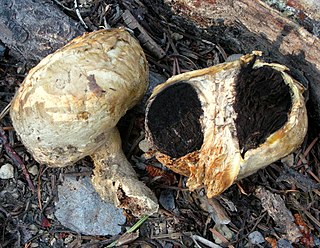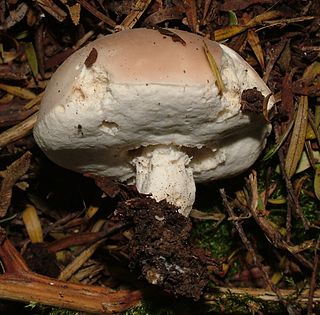
A mushroom or toadstool is the fleshy, spore-bearing fruiting body of a fungus, typically produced above ground, on soil, or on its food source. Toadstool generally denotes one poisonous to humans.

Mycology is the branch of biology concerned with the study of fungi, including their taxonomy, genetics, biochemical properties, and use by humans. Fungi can be a source of tinder, food, traditional medicine, as well as entheogens, poison, and infection.

Secotioid fungi are an intermediate growth form between mushroom-like hymenomycetes and closed bag-shaped gasteromycetes, where an evolutionary process of gasteromycetation has started but not run to completion. Secotioid fungi may or may not have opening caps, but in any case they often lack the vertical geotropic orientation of the hymenophore needed to allow the spores to be dispersed by wind, and the basidiospores are not forcibly discharged or otherwise prevented from being dispersed —note—some mycologists do not consider a species to be secotioid unless it has lost ballistospory.

Edible mushrooms are the fleshy fruit bodies of several species of macrofungi. Edibility may be defined by criteria including the absence of poisonous effects on humans and desirable taste and aroma. Edible mushrooms are consumed for their nutritional and culinary value. Mushrooms, especially dried shiitake, are sources of umami flavor.

Lepiota is a genus of gilled mushrooms in the family Agaricaceae. All Lepiota species are ground-dwelling saprotrophs with a preference for rich, calcareous soils. Basidiocarps are agaricoid with whitish spores, typically with scaly caps and a ring on the stipe. Around 400 species of Lepiota are currently recognized worldwide. Many species are poisonous, some lethally so.

The Agaricaceae are a family of basidiomycete fungi and include the genus Agaricus, as well as basidiomycetes previously classified in the families Tulostomataceae, Lepiotaceae, and Lycoperdaceae.

Agaricus is a genus of mushroom-forming fungi containing both edible and poisonous species, with over 400 members worldwide and possibly again as many disputed or newly-discovered species. The genus includes the common ("button") mushroom and the field mushroom, the dominant cultivated mushrooms of the West.

Psilocybe weraroa, formerly Weraroa novae-zelandiae, is a secotioid fungus in the family Hymenogastraceae. It is endemic to New Zealand, where it grows in native forests from rotting wood and woody debris. Despite its pouch-like form this species is closely related to Psilocybe cyanescens and Psilocybe subaeruginosa. As a bluing member of the genus Psilocybe it contains the psychoactive compounds psilocin and psilocybin.
Endoptychum is a genus of secotioid fungi in the family Agaricaceae. Like the majority of secotioid taxa, the individual species of Endoptychum are thought to be recent mutations from agaricoid species, hence, Endoptychum is likely not a valid monophyletic genus.
Secotium is a genus of fungi in the family Agaricaceae. The members of this genus are closely related to ordinary Agaricus mushrooms, but do not open out in the usual way; this has given rise to the term "secotioid" for such mushrooms in general. They are thought to form an evolutionary link between agarics and gasteroid fungi. Secotium is a widespread genus, with species that are predominantly found in warm and arid regions.
Neonothopanus nambi is a poisonous and bioluminescent mushroom in the family Marasmiaceae. The genetic and molecular mechanisms underlying this species' bioluminescence were published in 2019, the first to be elucidated for a fungus. In 2020, genes from this fungus were used to create bioluminescent tobacco plants.

Agaricus deserticola, commonly known as the gasteroid agaricus, is a species of fungus in the family Agaricaceae. Found only in southwestern and western North America, A. deserticola is adapted for growth in dry or semi-arid habitats. The fruit bodies are secotioid, meaning the spores are not forcibly discharged, and the cap does not fully expand. Unlike other Agaricus species, A. deserticola does not develop true gills, but rather a convoluted and networked system of spore-producing tissue called a gleba. When the partial veil breaks or pulls away from the stem or the cap splits radially, the blackish-brown gleba is exposed, which allows the spores to be dispersed.

Montagnea arenaria is a species of secotioid fungus in the family Agaricaceae. Originally named Agaricus arenarius by Augustin Pyramus de Candolle in 1815, it was transferred to the genus Montagnea by Sanford Myron Zeller in 1943. The species is characterized by a cap that has an apical disc, radial gills, a hymenophore, and spores with a prominent germ pore. It is inedible.
Neonothopanus gardneri, locally known as flor de coco, is a bioluminescent fungus native to Goiás, Piauí and Tocantins states in Brazil.

Agaricus inapertus is a species of secotioid fungus in the genus Agaricus. It was first described by American mycologists Rolf Singer and Alexander H. Smith in 1958 as Endoptychum depressum. Molecular analysis later proved it to be aligned with Agaricus, and it was formally transferred in a 2003 publication.

Cortinarius porphyroideus, commonly known as purple pouch fungus, is a secotioid species of fungus endemic to New Zealand. It was one of six species that appeared as part of a series depicting native New Zealand fungi on stamps, released in 2002.

Boletus semigastroideus is a species of secotioid fungus in the family Boletaceae. It was originally described in 1942 as Secotium areolatum by New Zealand-based mycologist Gordon Herriot Cunningham and then renamed as Notholepiota areolata as the type species of the genus Notholepiota by Egon Horak in 1971. A molecular phylogenetics study found it to belong in Boletus sensu stricto, but the name Boletus areolatus was preoccupied, so it was renamed Boletus semigastroideus.

Chlorophyllum agaricoides, known commonly as the puffball parasol, false puffball, or puffball agaric, is a species of fungus belonging to the family Agaricaceae. When young, it is edible, and has been traditionally eaten in Turkey for many years.

Clavogaster virescens is a species of secotioid or pouch-like fungus in the family Strophariaceae. It is endemic and indigenous to New Zealand, where it grows on rotting wood in native bush and mixed native and introduced forests. It has a stout yellowish stem, and a powder blue, purplish or greenish blue cap that forms a pouch, often referred to as a peridium, enclosing reddish brown or orange chambered gleba. The species is sometimes known as the "Spindle Pouch".













